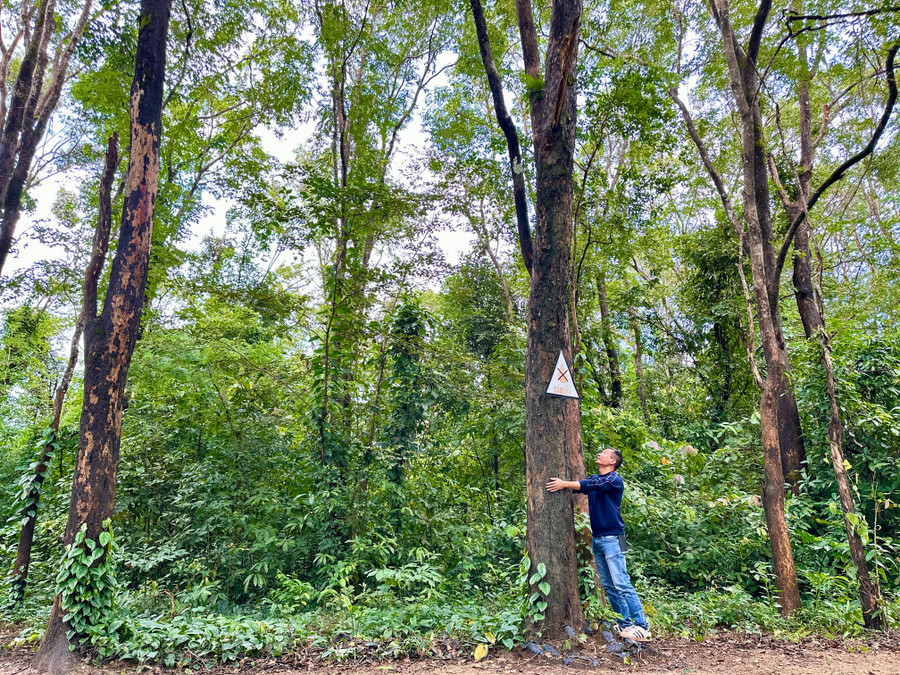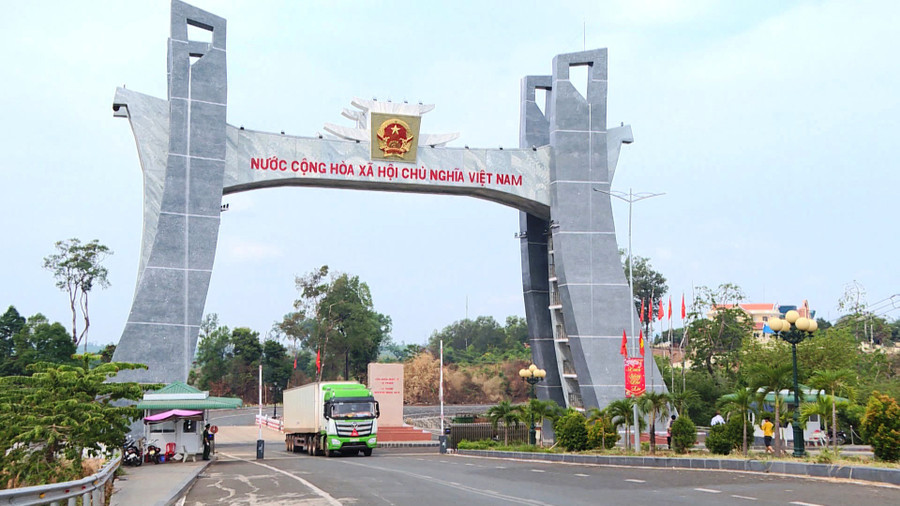If these destinations are connected into a continuous tourist route, it will be an important "push" to promote socio -economic development in border areas.
"Treasure" of the incense forest
About 8 km south from the center of Duc Co commune, in the middle of the vast rubber forest in Gron village, is a rosewood forest of nearly 4 hectares. According to the people who are guarding this forest, the rosewood forest has about 2,000 interwoven trees, of which about 1,400 trees have a diameter of 30-60 cm, growing straight. Some trees are nearly 50 m high, with a cool canopy.

Mr. Ro Mah Kem, one of the guards of the rosewood forest, recounted: Around 1995, seeing that this rare rosewood forest was at risk of being encroached upon by illegal loggers, the villagers of Gron met with the local government to coordinate in protecting the forest.
“The villagers are aware that this is a rare forest, a treasure of the village, and must not be cut down. The surrounding villages also know this, each person becomes the eyes and ears, if they see any suspicious activity, they immediately call the security force as well as the local authorities to come immediately” - Mr. Kem shared.
The determination and consensus of the people, combined with the responsibility of the government, have kept the forest intact for nearly 30 years. This is currently a rare and "unique" rosewood forest in the Central Highlands. Not only that, the rosewood forest has become an attractive sightseeing and experience spot for tourists and students from schools in the area.
The Bodhisattvas' exploits are left behind
The victory at Chu Bo (Chu Bo 1 village, Ia Dok commune) was one of the resounding victories of Division 320 (Army Corps 34) in the resistance war against the US, creating a favorable position on the Central Highlands battlefield. To achieve the victory at Chu Bo, nearly 100 officers and soldiers of Division 320 heroically sacrificed their lives.
The stele of Chu Bo historical relic clearly states: The 81st Border Commando Battalion of Military Region 2, Army of the Republic of Vietnam occupied Chu Bo base. Chu Bo base, together with Duc Co base (2 km west of Chu Bo), formed a continuous defensive cluster, blocking the extended Highway 19 axis, preventing and controlling our activities on the Vietnam - Cambodia border.
On January 18, 1973, the 64th Infantry Regiment of the 320A Division was reinforced by the 3rd Battalion (48th Regiment) and a number of other firepower units commanded by Lieutenant Colonel Khuat Duy Tien, along with local troops and civilians, opened fire to attack the Chu Bo stronghold. After nearly 2 hours of fighting, we completely controlled the stronghold (killed 220 enemies, captured 37 enemies, shot down 4 planes, collected 91 guns of various types, 12 radios...).
On January 20, 1973, the 64th Infantry Regiment attacked and destroyed the Duc Co stronghold. The victory at Chu Bo-Duc Co eliminated the enemy's outpost base, thwarted their plot to entrench themselves and turned this stronghold into a springboard, a starting point for encroachment operations, contributing to consolidating and expanding the liberated zone and the Vietnam-Cambodia border.
This victory created a new favorable situation for us, while ensuring the safety of the strategic transport route to support the southern battlefield.
On January 16, 2021, the People's Committee of Gia Lai province (old) decided to rank the Chu Bo Victory relic as a provincial-level historical relic. Mr. Nguyen Ngoc Nam - Chairman of the People's Committee of Ia Dok commune - affirmed: This relic has both historical value and is convenient for connecting to historical-cultural tours .
Under the shade of the heritage tree
Visitors from afar arriving at the entrance of Ghe village (Ia Dok commune) can see the canopy of an ancient banyan tree that casts a cool shade over an area. The tree is about 45 meters high, the circumference of the main trunk is about 13 meters and 8 secondary trunks spread out hundreds of square meters, very beautiful. A section of the banyan tree's roots crosses the Ia Ghe stream like a natural bridge leading to the other side.
In 2016, the Vietnam Association for Conservation of Nature and Environment officially recognized the Ghe village banyan tree as a Vietnam Heritage Tree. Since then, the Ghe village banyan tree has become a tourist destination.
Ghe villagers say that the banyan tree may be more than 200 years old. During the resistance against the French and the Americans, the banyan tree of Ghe village was a place to shelter soldiers. Until now, all community activities of the village still regularly take place under the shade of the old banyan tree.
Ms. Ro Mah H'Nhan (25 years old, a resident of Ghe village) said: "I hope that each villager, with their different contributions, will work together to preserve and conserve the traditional culture of the nation, thereby contributing to the development of local tourism. Personally, I will try to bring the image of the banyan tree to many people."
Majestic National Gate
At milestone 30, Le Thanh International Border Gate, the national gate stands tall amidst the wind and sun of the border. The structure is stylized in the image of a Central Highlands communal house, 46 m long, 18 m wide and 33 m high, completed in 2019. The sturdy reinforced concrete frame, steel crossbeams covered with fiberglass reinforced concrete panels, flags hanging on both sides, in the middle is engraved the words "Le Thanh International Border Gate" in Vietnamese and English.

Photo: Ha Duy
This place has long become a symbol, a check-in point for tourists when coming to the Gia Lai border area. Some people go in groups, some people go alone just to touch the 30th milestone once.
Connecting potential, awakening border tourism
Not only the 4 outstanding destinations mentioned above, the border area of Gia Lai province adjacent to Ratanakiri province (Kingdom of Cambodia) also has many beautiful and attractive landscapes that can be built into new and unique tours such as Ong Dong waterfall, Doi stream... These are the potentials and strengths to promote border tourism development, thereby leading to the socio-economic development of the region.
Previously, Duc Co district (old) had built a tourism development project with 4 main routes. In which, the domestic tourism route of Duc Co district has the Ghe village banyan tree - incense forest, the historical site of Chu Ty Victory - Chu Bo - Duc Co Martyrs Cemetery - Ho Chi Minh road - Le Thanh International Border Gate, Ong Dong waterfall - Doi stream.
The inter-district tourist route within Gia Lai province (old) has Bien Ho - yellow muong flower Chu Prong - banyan tree of Ghe village. The inter-provincial tourist route through Duc Co district has Quy Nhon - Le Thanh International Border Gate, Ia Dao stream - Ong Dong waterfall - Buon Don tourist area. The international tourist route has Gia Lai - Ratanakiri, Gia Lai - Stung Treng - Ratanakiri.
To realize that goal, it is necessary to promote, build brands, invest in accommodation and service infrastructure, and encourage the community to participate in tourism activities. Then, the border area will not only be a place to preserve historical memories and cultural values, but also become a bright spot on the local and regional tourism map.
Source: https://baogialai.com.vn/chuoi-ngoc-tren-vung-bien-gioi-gia-lai-post565268.html




![[Photo] National Assembly Chairman Tran Thanh Man attends the VinFuture 2025 Award Ceremony](/_next/image?url=https%3A%2F%2Fvphoto.vietnam.vn%2Fthumb%2F1200x675%2Fvietnam%2Fresource%2FIMAGE%2F2025%2F12%2F05%2F1764951162416_2628509768338816493-6995-jpg.webp&w=3840&q=75)


![[Photo] 60th Anniversary of the Founding of the Vietnam Association of Photographic Artists](/_next/image?url=https%3A%2F%2Fvphoto.vietnam.vn%2Fthumb%2F1200x675%2Fvietnam%2Fresource%2FIMAGE%2F2025%2F12%2F05%2F1764935864512_a1-bnd-0841-9740-jpg.webp&w=3840&q=75)






































































































Comment (0)